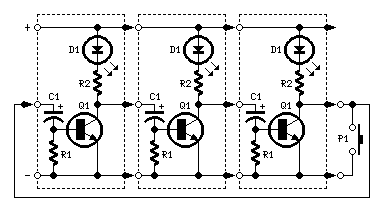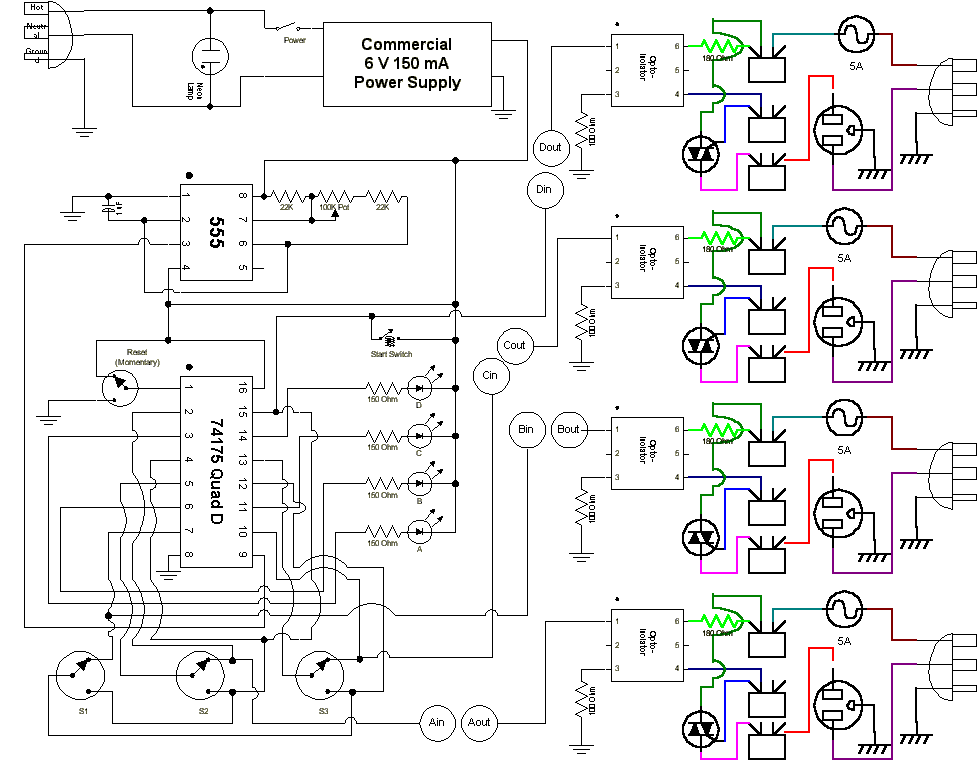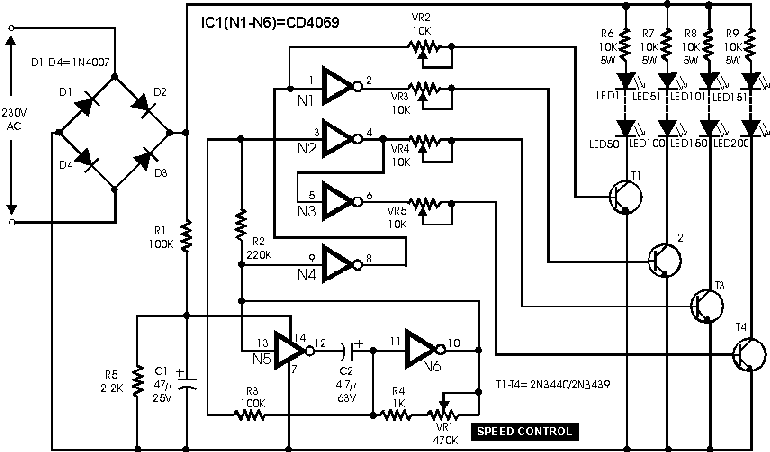
LEDs or Lamps Sequencer

The purpose of this circuit is to create a ring in which LEDs or lamps illuminate sequentially. Its main feature is high versatility; a loop containing any number of LEDs or lamps can be built, as each illuminating device has its own small circuit. The diagrams illustrate three-stage circuits for simplicity, with the capability to add an unlimited number of stages, provided the last stage output is returned to the first stage input. The P1 pushbutton allows for a reliable start of the sequence at power-on and, when a high number of stages is used, it can also enable the illumination of more than one LED or lamp simultaneously, for example, one device illuminated while three are off, and so on. After power-on, P1 should be held closed until only the LED or lamp associated with the module to which the pushbutton is connected remains steadily illuminated. When P1 is released, the sequencer starts. If P1 is pressed briefly after the sequence has started, various types of sequences can be achieved, depending on the total number of stages. Using a 24V supply (the maximum permitted voltage), approximately 10 LEDs wired in series can be connected to each module, around 7 at 15V, and no more than 5 at 12V. If lamps drawing more than 400mA current are intended for use, BC337 transistors should be replaced with Darlington types such as BD677, BD679, BD681, 2N6037, 2N6038, 2N6039, etc. A similar design was published about forty years ago, utilizing germanium transistors and low voltage lamps. The current design, which employs LEDs, silicon transistors, Darlington transistors, and a 24V supply, represents a significant improvement.
This circuit implements a sequential LED or lamp illumination system, characterized by its modular design and flexibility. The basic operational principle involves a series of stages, each consisting of a small circuit dedicated to an individual LED or lamp. The sequential nature of the illumination is achieved by connecting the output of the final stage back to the input of the first stage, forming a feedback loop that allows for continuous operation.
The P1 pushbutton serves a dual purpose: it initiates the sequence upon power-on and provides a method for controlling the illumination of multiple devices simultaneously. This functionality is particularly useful in scenarios where a lengthy sequence is desired, as it allows for the selection of specific devices to remain illuminated while others are turned off. The requirement to hold P1 closed until a designated LED or lamp is illuminated ensures that the circuit is properly initialized before the sequencer begins its operation.
The design accommodates various voltage levels, with the maximum permissible input being 24V. This allows for a higher number of LEDs to be connected in series, optimizing the circuit for different applications. The use of BC337 transistors is suitable for standard current loads; however, for higher current demands exceeding 400mA, the circuit can be upgraded by substituting these transistors with more robust Darlington types, ensuring reliability and performance under increased load conditions.
This modern iteration of the circuit, leveraging advancements in semiconductor technology, offers enhanced efficiency and performance compared to earlier designs that utilized germanium transistors and low voltage lamps. The incorporation of silicon transistors and LEDs represents a significant step forward, providing a more durable and energy-efficient solution for sequential lighting applications.The purpose of this circuit was to create a ring in which LEDs or Lamps illuminate sequentially. Its main feature is a high versatility: you can build a loop containing any number of LEDs or Lamps, as each illuminating device has its own small circuit. The diagrams show three-stage circuits for simplicity: you can add an unlimited number of stages (shown in dashed boxes), provided the last stage output was returned to the first stage input, as shown. P1 pushbutton purpose is to allow a sure start of the sequence at power-on but, when a high number of stages is used, it also allows illumination of more than one LED or Lamp at a time, e.
g. one device illuminated and three out and so on. After power-on, P1 should be held closed until only the LED or Lamp related to the module to which the pushbutton is connected remains steady illuminated. When P1 is released the sequencer starts: if P1 is pushed briefly after the sequence is started, several types of sequence can be obtained, depending from the total number of stages.
* Using 24V supply (the maximum permitted voltage), about 10 LEDs wired in series can be connected to each module, about 7 at 15V and no more than 5 at 12V. * If you intend to use lamps drawing more than 400mA current, BC337 transistors should be substituted by Darlington types like BD677, BD679, BD681, 2N6037, 2N6038, 2N6039 etc.
* A similar design appeared in print about forty years ago. It used germanium transistors and low voltage lamps. I think the use of LEDs, silicon transistors, Darlington transistors and 24V supply an interesting improvement. 🔗 External reference
This circuit implements a sequential LED or lamp illumination system, characterized by its modular design and flexibility. The basic operational principle involves a series of stages, each consisting of a small circuit dedicated to an individual LED or lamp. The sequential nature of the illumination is achieved by connecting the output of the final stage back to the input of the first stage, forming a feedback loop that allows for continuous operation.
The P1 pushbutton serves a dual purpose: it initiates the sequence upon power-on and provides a method for controlling the illumination of multiple devices simultaneously. This functionality is particularly useful in scenarios where a lengthy sequence is desired, as it allows for the selection of specific devices to remain illuminated while others are turned off. The requirement to hold P1 closed until a designated LED or lamp is illuminated ensures that the circuit is properly initialized before the sequencer begins its operation.
The design accommodates various voltage levels, with the maximum permissible input being 24V. This allows for a higher number of LEDs to be connected in series, optimizing the circuit for different applications. The use of BC337 transistors is suitable for standard current loads; however, for higher current demands exceeding 400mA, the circuit can be upgraded by substituting these transistors with more robust Darlington types, ensuring reliability and performance under increased load conditions.
This modern iteration of the circuit, leveraging advancements in semiconductor technology, offers enhanced efficiency and performance compared to earlier designs that utilized germanium transistors and low voltage lamps. The incorporation of silicon transistors and LEDs represents a significant step forward, providing a more durable and energy-efficient solution for sequential lighting applications.The purpose of this circuit was to create a ring in which LEDs or Lamps illuminate sequentially. Its main feature is a high versatility: you can build a loop containing any number of LEDs or Lamps, as each illuminating device has its own small circuit. The diagrams show three-stage circuits for simplicity: you can add an unlimited number of stages (shown in dashed boxes), provided the last stage output was returned to the first stage input, as shown. P1 pushbutton purpose is to allow a sure start of the sequence at power-on but, when a high number of stages is used, it also allows illumination of more than one LED or Lamp at a time, e.
g. one device illuminated and three out and so on. After power-on, P1 should be held closed until only the LED or Lamp related to the module to which the pushbutton is connected remains steady illuminated. When P1 is released the sequencer starts: if P1 is pushed briefly after the sequence is started, several types of sequence can be obtained, depending from the total number of stages.
* Using 24V supply (the maximum permitted voltage), about 10 LEDs wired in series can be connected to each module, about 7 at 15V and no more than 5 at 12V. * If you intend to use lamps drawing more than 400mA current, BC337 transistors should be substituted by Darlington types like BD677, BD679, BD681, 2N6037, 2N6038, 2N6039 etc.
* A similar design appeared in print about forty years ago. It used germanium transistors and low voltage lamps. I think the use of LEDs, silicon transistors, Darlington transistors and 24V supply an interesting improvement. 🔗 External reference





